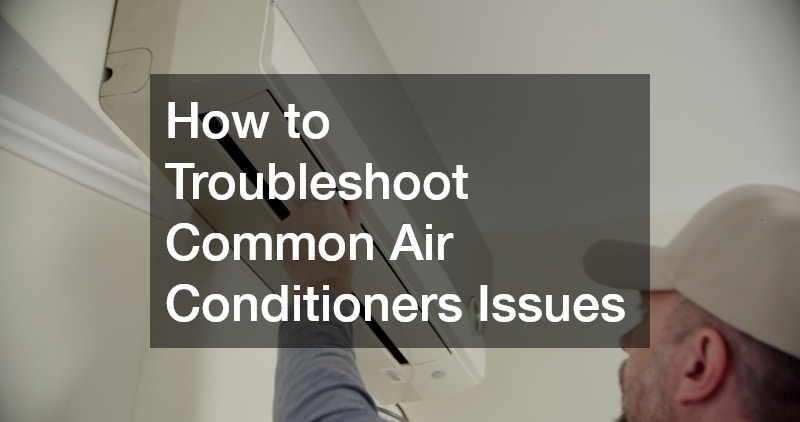How to Troubleshoot Common Air Conditioners Issues
As summer arrives and temperatures climb, a reliable cooling system becomes essential for comfort and health. When air conditioners malfunction, they not only disrupt daily life but also lead to higher energy bills and potential damage if not addressed promptly. Fortunately, many common air conditioner problems can be identified and resolved without professional help.
By understanding typical issues and how to troubleshoot them, homeowners can keep their systems running efficiently throughout the warmer months.
1. Air Conditioner Not Turning On
One of the most frequent concerns is an air conditioner that fails to start. Before panicking, check the basics. Ensure the power supply is working by testing the outlet or circuit breaker. A tripped switch or blown fuse is often the culprit. If the unit has a reset button, press it and wait a few minutes. Also, verify that the thermostat is set to ‘cool’ and the temperature is below the current room level. Sometimes, a faulty thermostat may need replacement or recalibration.
2. Poor Cooling Performance
If your air conditioner is running but not cooling as expected, several factors could be responsible. Begin by inspecting the air filters. Clogged or dirty filters restrict airflow, forcing the system to work harder and reducing its effectiveness. Clean or replace filters monthly during peak use. Also, check that windows and doors are sealed properly to prevent cool air from escaping.
The outdoor condenser unit should also be clean and free of obstructions such as leaves or debris. If the coils are dirty, they cannot effectively dissipate heat, which reduces the system’s cooling ability. Use a garden hose to gently rinse the coils or schedule routine maintenance for more thorough cleaning.
3. Unusual Noises or Vibrations
While air conditioners are not silent, unusual sounds such as grinding, rattling or buzzing may indicate mechanical issues. A rattling noise could mean loose panels or screws, while buzzing might suggest electrical problems. Grinding often points to motor or bearing issues. Always turn off the system before inspecting it and tighten any visible screws or panels. If the noise persists, contact a qualified technician, as internal component damage could worsen over time.
4. Water Leaks or Excess Moisture
Water pooling around the unit or noticeable dampness inside could signal a blocked or disconnected drainpipe. Air conditioners remove humidity from the air and this moisture is supposed to drain away via a pipe. When the pipe becomes clogged with dirt or algae, the water backs up and can overflow. Flush the line with a mixture of vinegar and water or use a wet/dry vacuum to remove the blockage.
Indoor units may also leak if the evaporator coil freezes. This usually happens due to restricted airflow or low refrigerant levels. If you see ice buildup on the coil or suspect low refrigerant, turn off the unit and allow it to thaw. Replace the filter and restart the system. If freezing recurs, a refrigerant leak might be present and a licensed technician should assess the issue.
5. Foul Odours
Musty or unpleasant smells coming from the air coolers typically indicate mould or mildew growth in the system. This is common in humid climates or when filters and ducts are not cleaned regularly. Replace the filter and clean vents with a mild disinfectant. For deeper issues within the ductwork or evaporator coil, schedule a professional cleaning. Preventive maintenance, such as using a dehumidifier in damp areas and keeping the unit dry, helps control odour problems.
6. Short Cycling
Short cycling occurs when an air conditioner turns on and off too frequently, which reduces energy efficiency and strains the compressor. Causes include oversized units, thermostat placement near heat sources or dirty filters. Start by replacing the filter and ensuring the thermostat is placed away from windows and appliances. If the problem continues, have a technician assess whether the unit is properly sized for your home.
7. High Energy Bills
If your power bills are unusually high during the cooling season, your air conditioner might be underperforming. Dirty filters, ageing components, refrigerant leaks or even incorrect thermostat settings can cause the system to consume more energy. Ensure regular maintenance, clean filters and correct thermostat programming to maximise efficiency. Upgrading to a modern, energy-efficient model may also reduce long-term costs.
Preventative Measures & Maintenance

Routine maintenance is the key to preventing common air conditioner issues. Schedule professional servicing at least once a year, ideally in early spring, to ensure the system is ready for increased use. Regularly inspect outdoor units, clear away debris and clean filters monthly. Also, monitor system performance to detect early signs of trouble.
By understanding and addressing common air conditioner issues early, homeowners can maintain reliable cooling throughout summer. Regular maintenance, timely troubleshooting and knowing when to call a professional help ensure long-term performance and comfort during Australia’s hottest months.




Post Comment